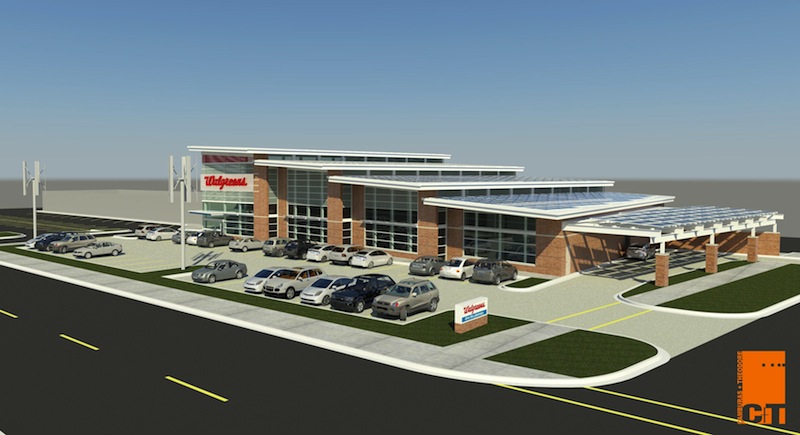Walgreens announced plans last week to build one of the nation's first net-zero retail stores. The Evanston, Ill., location will utilize solar panels, wind turbines, geothermal technology, LED lighting and ultra-high-efficiency refrigeration to produce energy equal to or greater than the building consumes.
The Chicago-area location will allow convenient access for Walgreens engineers based at the company’s headquarters in Deerfield, Ill., to measure the store’s performance for an entire year to determine if the store reaches its goal of net zero energy use.
Walgreens plans to generate electricity and reduce its usage by more than 40 percent through several technologies in the store including:
- more than 800 roof-top solar panels
- two wind turbines
- geothermal energy obtained by drilling 550-feet into the ground below the store, where temperatures are more constant and can be tapped to heat or cool the store in winter and summer
- LED lighting and daylight harvesting
- carbon dioxide refrigerant for heating, cooling and refrigeration equipment
- energy efficient building materials.
Engineering estimates--which can vary due to factors such as weather, store operations and systems performance- indicate that the store will use 200,000 kilowatt hours per year of electricity while generating 256,000 kilowatt hours per year.
Over the past year, Walgreens engineers have worked with the city of Evanston and vendors, including Trane, CREE Lighting, Acuity Lighting, Cooper Lighting, CalStar Products, GE Lighting, Geothermal International, SoCore Energy, Wing Power and Camburas and Theodore Architects.
(http://news.walgreens.com/article_display.cfm?article_id=5717)
Related Stories
| Aug 9, 2022
5 Lean principles of design-build
Simply put, lean is the practice of creating more value with fewer resources.
| Aug 9, 2022
Designing healthy learning environments
Studies confirm healthy environments can improve learning outcomes and student success.
Legislation | Aug 8, 2022
Inflation Reduction Act includes over $5 billion for low carbon procurement
The Inflation Reduction Act of 2022, recently passed by the U.S. Senate, sets aside over $5 billion for low carbon procurement in the built environment.
| Aug 8, 2022
Mass timber and net zero design for higher education and lab buildings
When sourced from sustainably managed forests, the use of wood as a replacement for concrete and steel on larger scale construction projects has myriad economic and environmental benefits that have been thoroughly outlined in everything from academic journals to the pages of Newsweek.
AEC Tech | Aug 8, 2022
The technology balancing act
As our world reopens from COVID isolation, we are entering back into undefined territory – a form of hybrid existence.
Legislation | Aug 5, 2022
D.C. City Council moves to require net-zero construction by 2026
The Washington, D.C. City Council unanimously passed legislation that would require all new buildings and substantial renovations in D.C. to be net-zero construction by 2026.
Cultural Facilities | Aug 5, 2022
A time and a place: Telling American stories through architecture
As the United States enters the year 2026, it will commence celebrating a cycle of Sestercentennials, or 250th anniversaries, of historic and cultural events across the land.
Sponsored | | Aug 4, 2022
Brighter vistas: Next-gen tools drive sustainability toward net zero line
New technologies, innovations, and tools are opening doors for building teams interested in better and more socially responsible design.
| Aug 4, 2022
Newer materials for green, resilient building complicate insurance underwriting
Insurers can’t look to years of testing on emerging technology to assess risk.
Sustainability | Aug 4, 2022
To reduce disease and fight climate change, design buildings that breathe
Healthy air quality in buildings improves cognitive function and combats the spread of disease, but its implications for carbon reduction are perhaps the most important benefit.

















